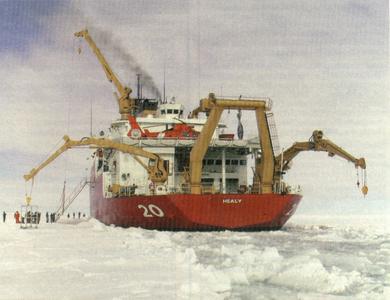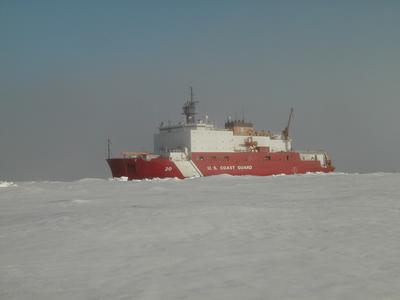
|
|
17 August, 2002
Yesterday I told you that the U.S. Coast Guard was originally known as the
Revenue Cutter Service. One of the early captains in the Revenue Cutter
Service was Michael Healy for whom the USCGC Healy is named. Mike Healy was
born in Macon, Georgia in 1839, the son of an Irish plantation owner and his
common-law wife of 20 years, one of his slaves. As the son of a slave, Mike
Healy was, by law, a slave. His father could not free him, his seven
brothers and sisters, or his mother. When his parents both died within six
months of each other, six of his siblings entered the Catholic Church as
priests or nuns. (Much later, the eldest brother was appointed the Bishop
of Maine, and another brother became the first president of Georgetown
University.) Although his siblings urged him to join the church, Mike Healy
ran away to sea at the age of 15. After working on ships in the
Mediterranean, he returned to the states and applied for a commission in the
Marine Revenue Service. By the time he arrived in San Francisco, the
California gold rush had faded, and the newest frontier was the Alaska
Territory where the fur trade lured many despite the dangers.
When the U.S. Congress purchased Alaska from Russia in 1867, they dispatched
ships to survey the area and the Revenue Cutter Service not only carried out
that job, but also became the only police force in the area. By then, Mike
Healy was Captain of the Bear, a sailing ship in the Revenue Cutter Service.
For many of the Alaskan natives, Mike Healy was their only contact with the
outside world. The policymakers in Washington looked upon the natives as
barbarians and wanted to "civilize" them. They essentially ignored the
culture and traditions of the native people. Some feel that, because Mike
Healy was an African American who chose to pass as white (he would not have
been allowed in the Revenue Cutter Service if it was known he was African
American), he had a special sympathy for the Alaskan people. He enforced
the law, brought them supplies and medical help, and chased illegal traders.
To this day, the elders in many Alaskan villages tell stories of Captain
Mike Healy.
When other nations came to Alaska to hunt walrus, fur seals and whales, and
when high powered rifles and harpoon guns made hunting much easier, it was
Captain Healy who appealed to Washington to stop the hunting. By 1890, the
fur seals and bowhead whales that sustained the native Alaskans were close
to extinction. Famine swept through the coastal villages and whole villages
were wiped out by starvation. When Washington's response was slow, Captain
Healy transported reindeer from Siberia to Alaska where they flourished and
provided food for the people until the seal, whale and walrus populations
rebounded. By that time, Mike Healy was known from San Francisco to the
Arctic Circle as the man who represented law and justice for the 30,000-mile
coastline of Alaska. He had a reputation as a master navigator, unmatched
in courage and daring. Congress rewarded him for saving hundreds of lives
at sea.
At a time when a sailors' life was extremely difficult and dangerous (many
sailors had to be kidnapped and brought on board, because no one would take
the job), one of Captain Healy's jobs was to enforce maritime law at sea.
On one occasion, he responded to a report of mutiny on another ship by
ordering the sailors to be "triced" (tied up by their arms behind their
backs). Three men on board Healy's ship reported that he had been drinking
at the time of the order. When the report reached San Francisco, Captain
Healy was denounced as cruel and arrogant. The combined efforts of the
women of the temperance movement and the men of the sailors' union brought
Captain Healy before a Board of Inquiry. The masters and owners of the
northern whaling fleet as well as Alaskan natives, school children and
teachers rallied around to support him. Captain Healy was exonerated, but
those in Washington began to see Mike Healy as an embarrassment to the
marine revenue service.
As new officers came into the service, they saw Captain Healy as a man stuck
in the old ways of the service. Although he had stopped drinking for a
period of time, Healy began drinking again, and he became more and more
isolated from others around him. He was formally charged with misconduct by
25 officers of the Bering Sea Patrol, relieved of his command and ordered
before a court martial. He was found guilty and suspended from duty for
four years. When gold was discovered in Alaska, the Marine Revenue Service
needed all officers and they offered Captain Healy another command at the
age of 60. He was in poor health and his behavior became erratic while at
sea. He was relieved of his duty and he died of a heart attack in 1904.
Despite his personal struggles late in life, Captain Mike Healy remains a
hero to the Alaskan natives, and he still retains a reputation as one of the
most outstanding navigators of the treacherous waters of the Alaskan coast.
When the Coast Guard's newest icebreaker was commissioned in 2000, it was
named for Captain Michael Healy.
Note: Most of the information in today's journal comes from "The Odyssey of
Captain Healy," a 1999 Waterfront Soundings Production.

<> This picture of the USCGC Healy, taken from the stern during the spring curise, gives you an idea of the size of the ship if you look at it in comparison to the people out on the ice.

<> The USCGC Healy is named for Captain Michael Healy, one of the most famous captains of the United States Revenue Cutter Service.
Contact the TEA in the field at
.
If you cannot connect through your browser, copy the
TEA's e-mail address in the "To:" line of
your favorite e-mail package.
|
